112/3 Shelves
Search This Category
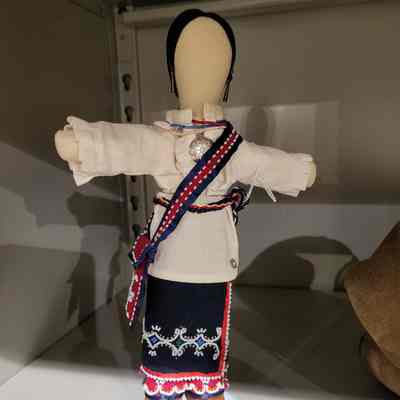
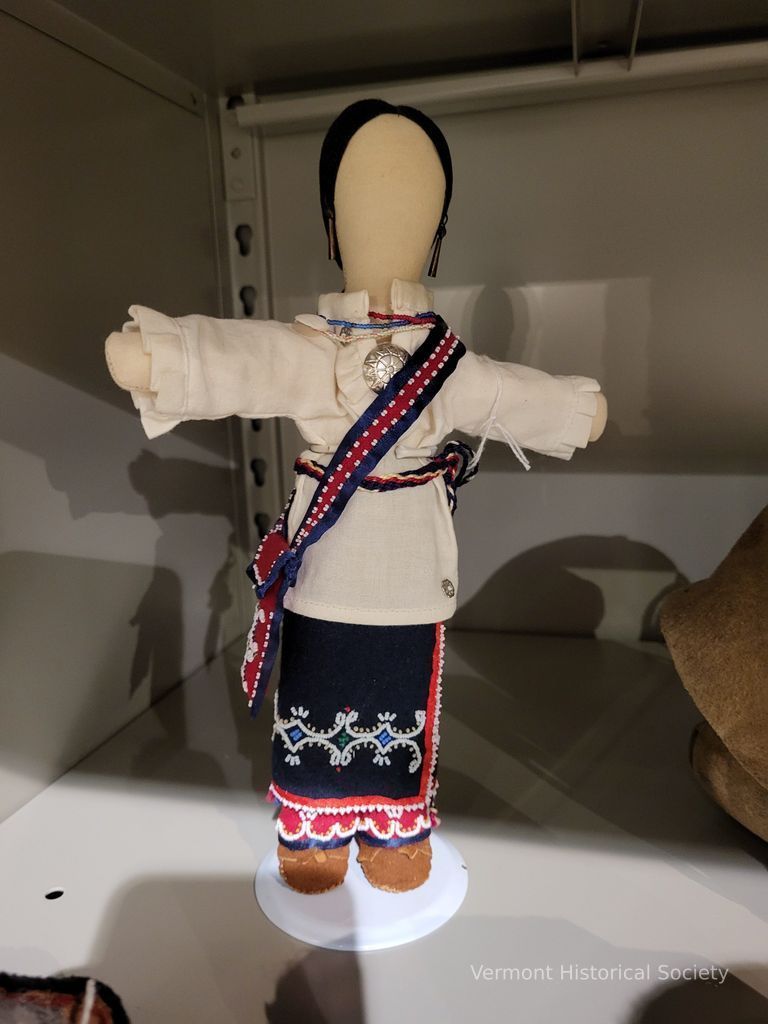
Abenaki Doll
Name/Title
Abenaki Doll
Lexicon
Description
Doll - needs description
Acquisition
Source (if not Accessioned)
Abenaki Cultural Conservancy
Ethnography
Made/Created
Artist Information
Willette, Lee
Artist
Date made
2005
Entry/Object ID
L2024.3.85
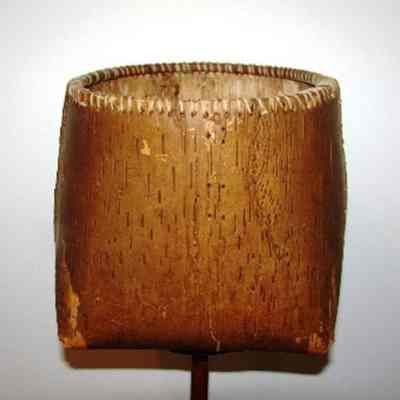

Bark Container
Name/Title
Bark Container
Lexicon
Description
Folded and stitched bark Container. Square base and round top. Marked on bottom, "K" and "1830."
Acquisition
Source (if not Accessioned)
Abenaki Cultural Conservancy
Ethnography
Made/Created
Date made
1830
Materials
Material
Birch
Entry/Object ID
L2024.3.108
Context
This is, perhaps, the largest and most stereotypically native bark container from Vermont. It is a folded bark form; with square bottom and circular rim called a “Makuk” (a Great Lakes area term) in the trade. Maine examples are usually much more tapered toward the top than this one. The 1830 date seems a bit early for the level of oxidation and patination of the bark.
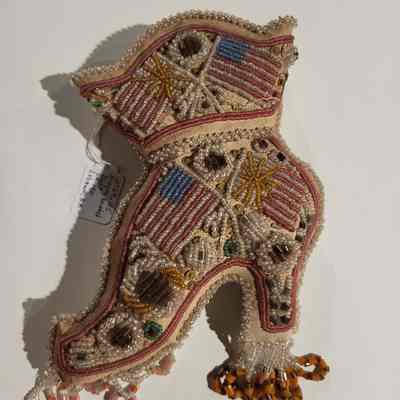

Beaded Boot Pillow
Name/Title
Beaded Boot Pillow
Lexicon
Description
Beaded boot in the Niagara style
Acquisition
Source (if not Accessioned)
Abenaki Cultural Conservancy
Made/Created
Date made
circa 1910
Entry/Object ID
L2024.3.95

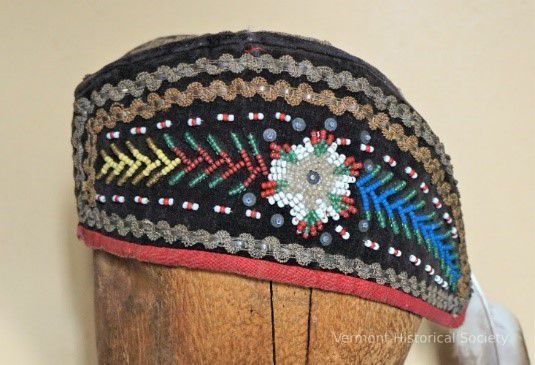
Beaded Glengarry Cap
Name/Title
Beaded Glengarry Cap
Lexicon
Description
The cap is in excellent shape, made of black velvet with a dark tan polished cotton lining and beaded with a mix of opaque and transparent clear and colored 11/0 beads. It has a damaged golden eagle feather pendant on the back. The design focus is a large six-pointed polychrome design intermediate between a flower and star with a central sequin. It is flanked by pinnate designs, with beaded and metallic sequin space fillers. Sequins are usually a good indicator of pre-20th century use. Gold ricrac and braided cotton tape edge trim completed the decorative design of the hat.
Acquisition
Source (if not Accessioned)
Abenaki Cultural Conservancy
Made/Created
Date made
circa 1880
Entry/Object ID
L2024.3.124
Context
Though apparently handed down in an Abenaki family, this item was thought to be an Iroquoian object. Upon further research into beadwork, Wiseman feels that it fits better into the Natural Style than the “Late Niagara.” This may indeed be Abenaki rather than Iroquois.
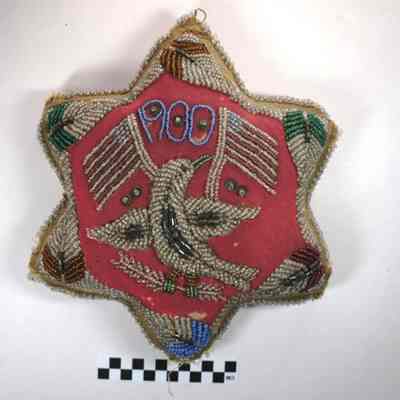

Beaded Whimsey
Name/Title
Beaded Whimsey
Lexicon
Description
Six-pointed star, beaded ornament. Glass beads of red, white, blue, and green. Designs include leaves at the point of each star, a Central dove holding an olive branch, the number 1900, and two American flags.
Acquisition
Source (if not Accessioned)
Abenaki Cultural Conservancy
Ethnography
Made/Created
Date made
circa 1900
Entry/Object ID
L2024.3.94
Context
Beaded in the Niagara style
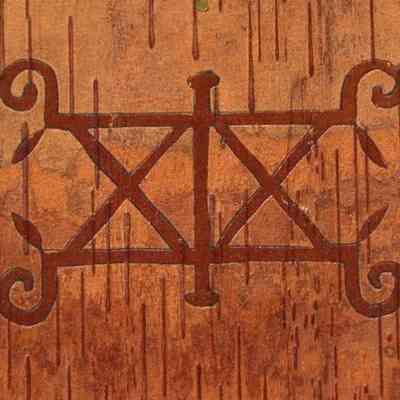
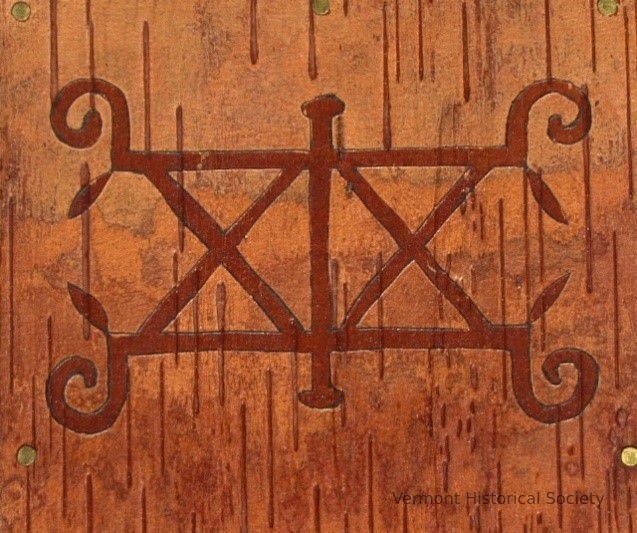
Birchbark Panel
Name/Title
Birchbark Panel
Lexicon
Description
Incised birchbark Panel with symbol of Wabanaki Confederacy
Acquisition
Source (if not Accessioned)
Abenaki Cultural Conservancy
Ethnography
Artwork Details
Medium
Wood
Subject
Wabanaki Confederacy
Made/Created
Artist Information
York, Aaron (b. 1973)
Artist
Date made
2005
Entry/Object ID
L2024.3.102
Context
This panel was created for Fred Wiseman as the cover art for his 2005 publication "Reclaiming the Ancestors."
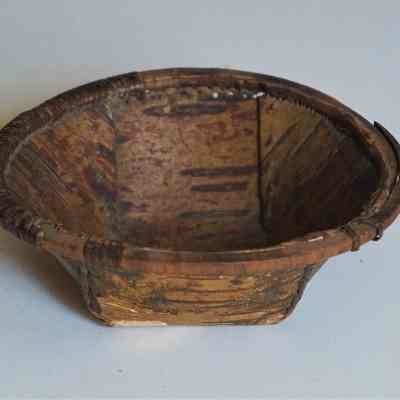
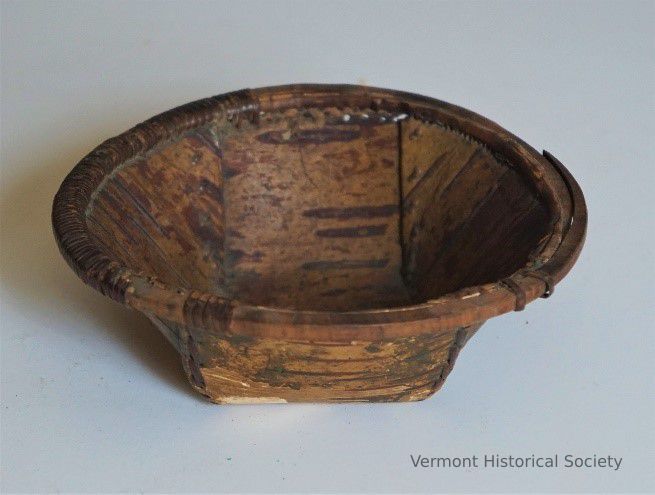
Bowl
Name/Title
Bowl
Lexicon
Description
Bowl fashioned from folded and stitched birchbark. The rim of the bowl is made from cut and bent wood and bound with spruce root.
Acquisition
Source (if not Accessioned)
Abenaki Cultural Conservancy
Ethnography
Made/Created
Date made
circa 1780-circa 1830
Materials
Material
Birch
Entry/Object ID
L2024.3.68
Context
This small, heavily oxidized bark bowl from southern Maine exhibits many early traits including the rectangular cut & shaved rim base and the careful spruce root wrapping that is almost all gone from years of hard use, evidence of native use rather than an early example of tourist art.

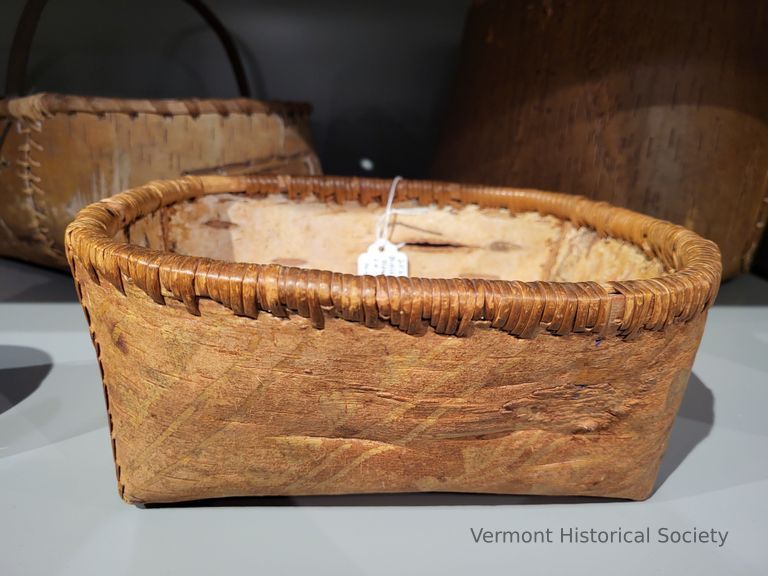
Bowl
Name/Title
Bowl
Lexicon
Description
Birchbark bowl with geometric lines and zigzags
Acquisition
Source (if not Accessioned)
Abenaki Cultural Conservancy
Made/Created
Date made
circa 1850
Materials
Material
Birch
Entry/Object ID
L2024.3.67
Context
I have never seen a bark container from our area with the type of variable length spruce root rim lashing like this example. The advantage of this is said to not have all the lashing holes in the bark in a line, so that the bark will not separate along the weakened axis of the holes. I have only seen one or two bark containers separate this way, so I doubt that this is an important structural element but seems rather a decorative one. This casts a measure of doubt on the local origin of this artifact. However, given the fact that nobody has studied bark containers from the American Abenaki area, it is important to archive it for future researchers. The sawtooth etched design has affinities to the Cambridge basket, possibly supporting a local origin.
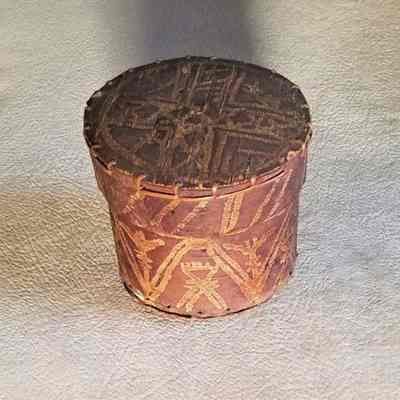
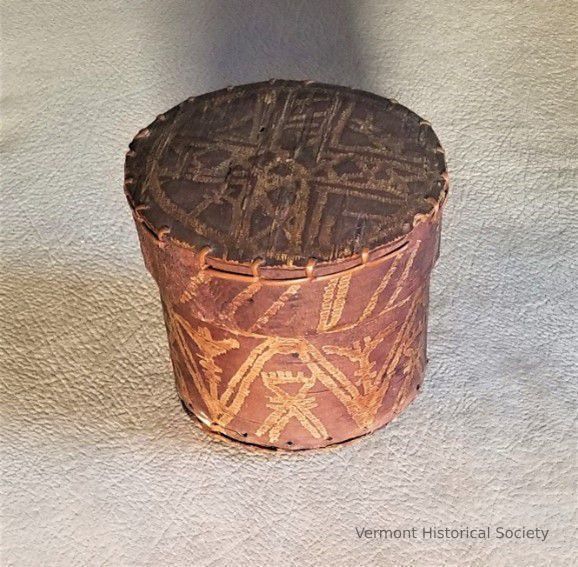
Box
Name/Title
Box
Lexicon
Description
Round birchbark box with incised "petroglyph" designs. Lid has rim reinforced with bent wood and spruce root sewing/binding.
Acquisition
Source (if not Accessioned)
Abenaki Cultural Conservancy
Ethnography
Made/Created
Date made
circa 1850
Dimensions
Materials
Material
Birch
Entry/Object ID
L2024.3.65a-b
Context
This small etched birch bark box from Lyme, New Hampshire has primitive “petroglyph” style designs on the lid, and on the sides. Frederick Wiseman states, "The size and manufacture is similar to the much more common, mid-Maine “Penobscot” bark boxes and may actually be an import from the east. However, I have never seen a box with these designs published as Penobscot work. The spruce root sewing on the lid is unique."
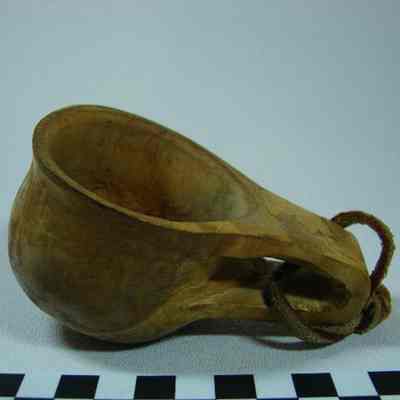
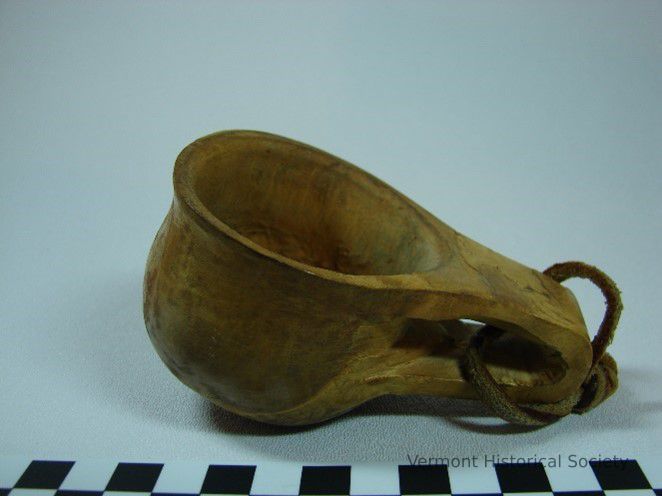
Canoe Cup
Name/Title
Canoe Cup
Lexicon
Description
Round cup carved from a single maple burl. Pierced handle with leather thong.
Acquisition
Source (if not Accessioned)
Abenaki Cultural Conservancy
Ethnography
Made/Created
Artist Information
Hakey, Ned
Artist
Date made
1956-1957
Materials
Material
Wood
Entry/Object ID
L2024.3.119
Context
This maple burl canoe cup was carved 1n 1956 or 1957 by Ned Hakey who lived on River Lane in Swanton. It represented the loon if turned upside down. The bowl was hollowed out by drilling then carving with a crooked knife.
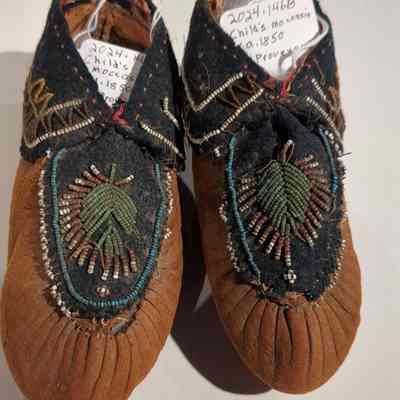
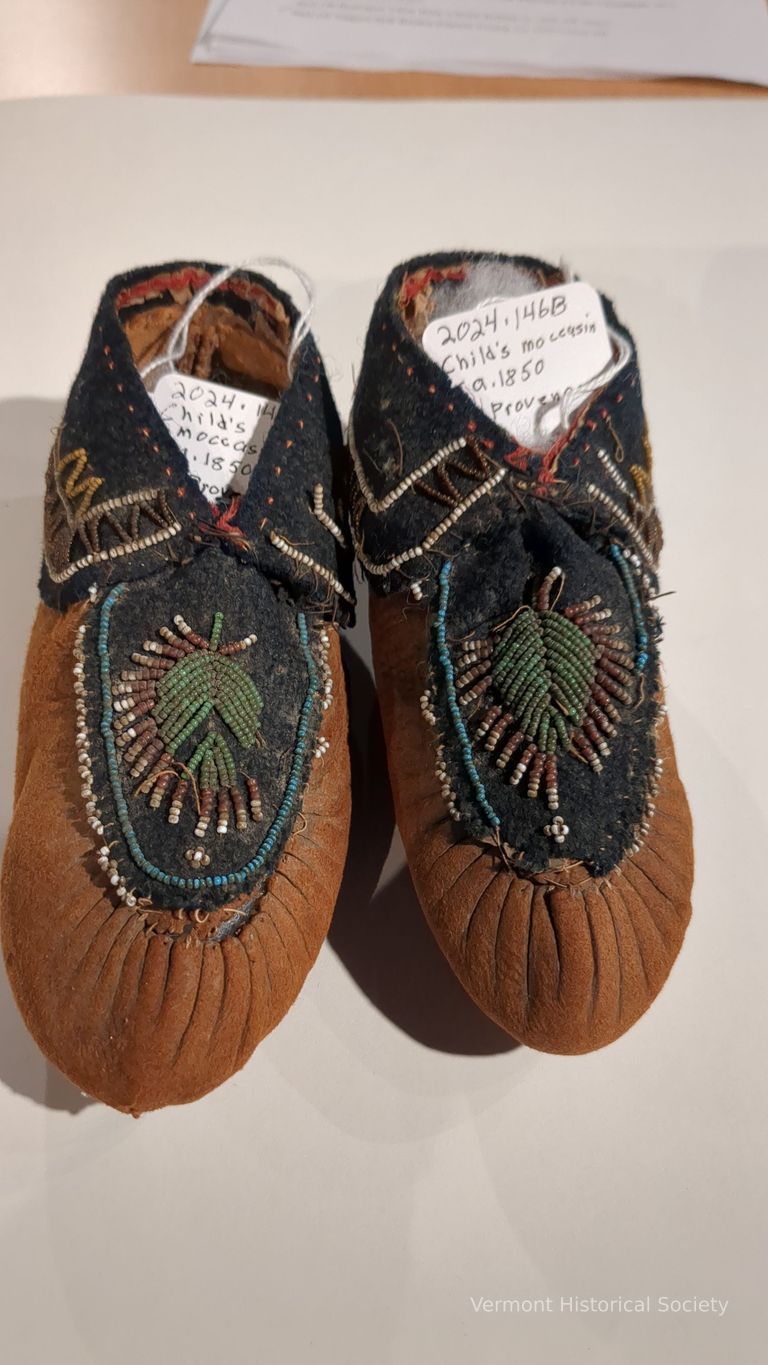
Child's Moccasins
Name/Title
Child's Moccasins
Lexicon
Clothing/Dress/Costume Details
Article of Clothing/Dress/Costume
Moccasins
Size
Child
Description
Small, buff moccasins with blue vamps and cuffs. Beaded thistle motif on vamps. Zig-zag border on cuffs.
Acquisition
Source (if not Accessioned)
Abenaki Cultural Conservancy
Ethnography
Made/Created
Date made
circa 1850
Entry/Object ID
L2024.3.146a-b
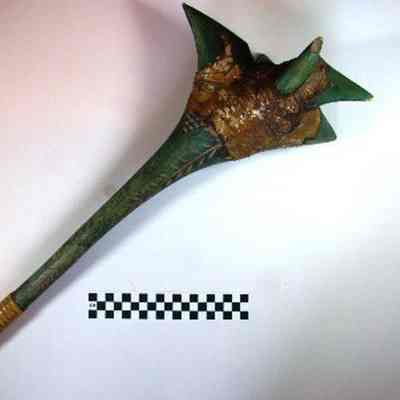

Club
Name/Title
Club
Lexicon
Description
Club made from a tree root. Painted green with a rattan handle. Floral and geometric designs etched into paint on handle.
Acquisition
Source (if not Accessioned)
Abenaki Cultural Conservancy
Relationships
Related Person or Organization
Gravel, Benjamin Frederick (1895-1988)
Person or Organization
Made/Created
Date made
circa 1910
Materials
Material
Wood
Entry/Object ID
L2024.3.71
Context
This aggressive looking green painted root club once belonged to Swanton Historian Ben Gravel and reappeared many years after his death at the 2010 Abenaki “Heritage Days” Powwow in Swanton, where Frederick Wiseman was able to purchase it.
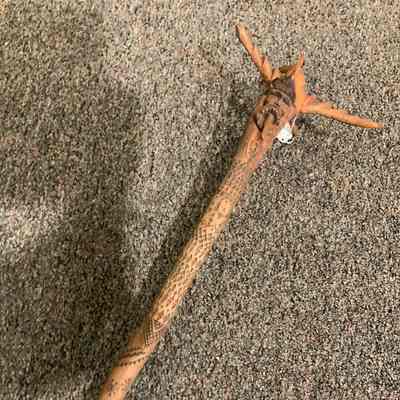
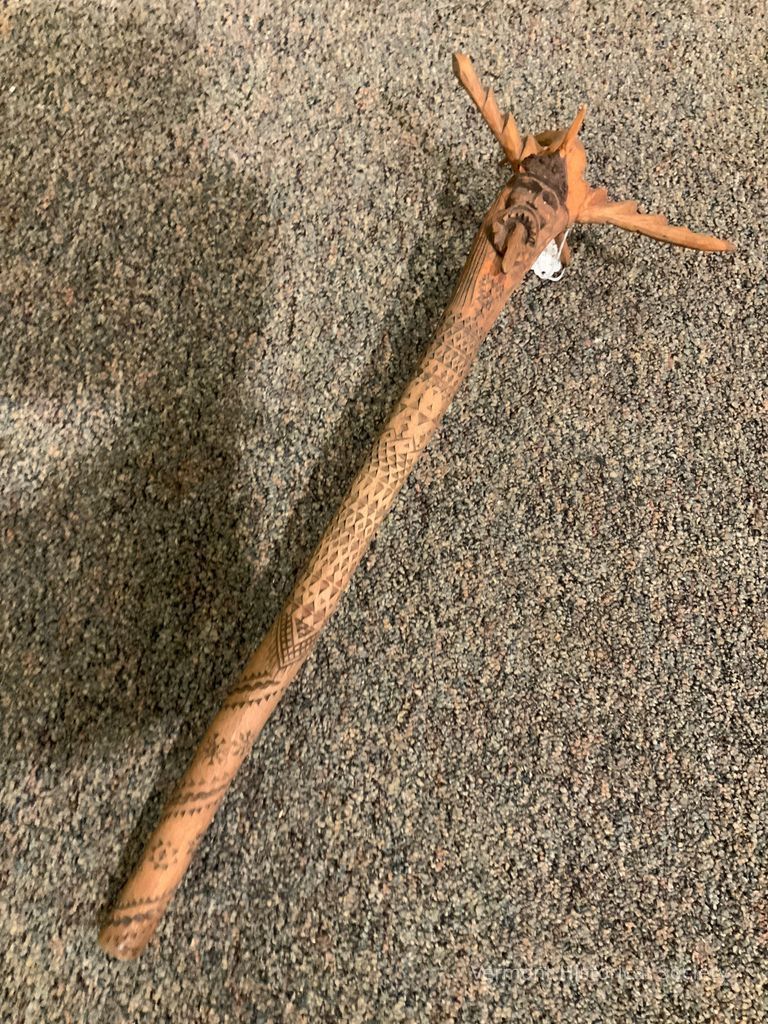
Club
Name/Title
Club
Lexicon
Description
Carved root club in form of man with antlers and extended tongue.
Acquisition
Source (if not Accessioned)
Abenaki Cultural Conservancy
Ethnography
Made/Created
Artist Information
York, Aaron (b. 1973)
Artist
Entry/Object ID
L2024.3.168
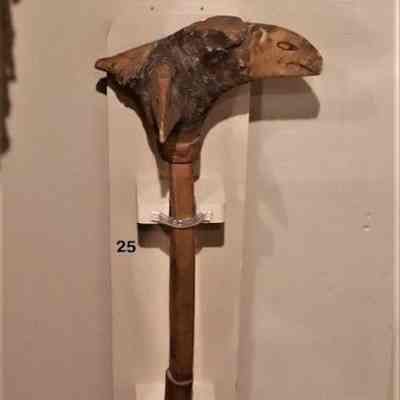

Club
Name/Title
Club
Lexicon
Description
Club made from a tree root carved as a bird beak.
Acquisition
Source (if not Accessioned)
Abenaki Cultural Conservancy
Made/Created
Date made
circa 1900
Materials
Material
Wood
Entry/Object ID
L2024.3.70
Context
Oral history evidence exists of a root club of this “bird-beak” style being used by a Nulhegan Abenaki family as a healing wand to keep away disease in the sickroom. We were lucky to find this larger, stylistically identical example in nearby Northern New Hampshire (provenance says Essex?).
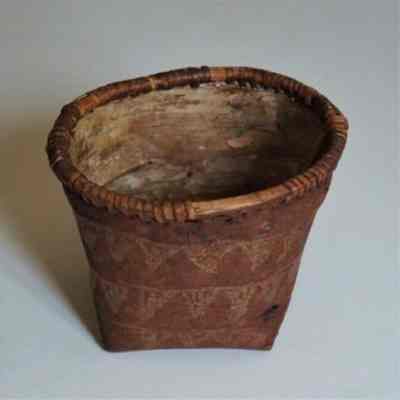

Container
Name/Title
Container
Lexicon
Description
Round birchbark container with square foot. Bent wood rim with spruce root binding. Incised floral and pendant toothed-triangles arranged in three rings around the outside of the vessel.
Acquisition
Source (if not Accessioned)
Abenaki Cultural Conservancy
Ethnography
Made/Created
Date made
circa 1840
Materials
Material
Birch
Entry/Object ID
L2024.3.66
Context
This small crudely constructed and etched birch bark basket from Cambridge, Lamoille County, Vermont has pendant toothed designs on the side shown in the photo, as well as floral designs on the other side, a rarity anywhere in the Wabanaki area. It has very significant patination and use wear, including spruce root lashing loss. This basket is from an area that had documentation of having been a place of bark container manufacture: ... as late as 1840, a number of families (of) St. Francis Indians came into the town (Cambridge, VT) and encamped and made ... bark dishes for a while (vermontgenealogy.com/lamoille/Indians).

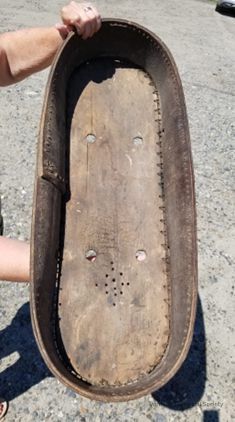
Cradleboard
Name/Title
Cradleboard
Lexicon
Description
Cradle made from oval basswood base with basswood bark sides bent and stitched. Base has four holes for carrying straps and a starburst of decorative holes near one end.
Acquisition
Source (if not Accessioned)
Abenaki Cultural Conservancy
Ethnography
Made/Created
Date made
circa 1840
Materials
Material
Basswood
Entry/Object ID
L2024.3.90
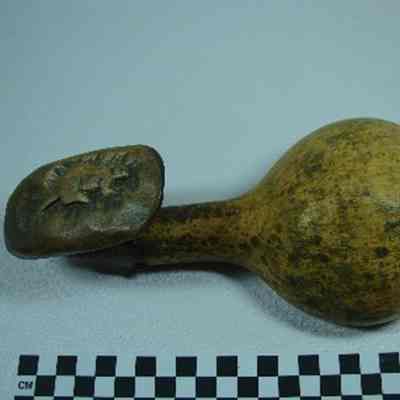
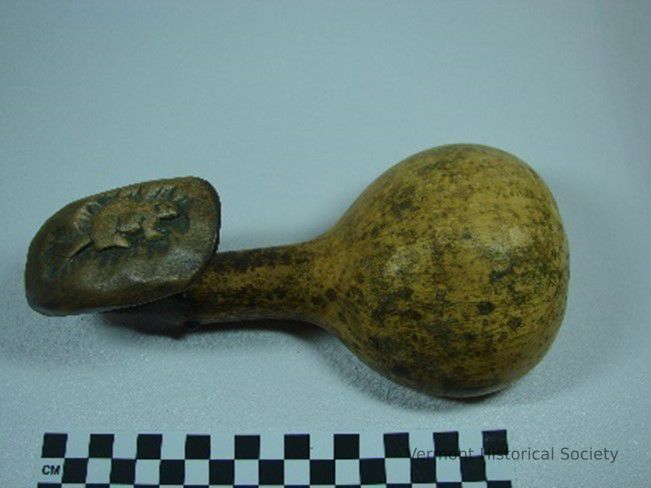
Cup
Name/Title
Cup
Lexicon
Description
Cup fashioned from gourd with attached wooden handle with low relief carving of beaver.
Use
Designed to fit under a waist sash with the hook, including beaver carving, facing outward.
Acquisition
Source (if not Accessioned)
Abenaki Cultural Conservancy
Ethnography
Made/Created
Date made
circa 1840
Materials
Material
Gourd, Wood
Entry/Object ID
L2024.3.25
Context
Canoe cups are a distinct art form, usually carved from a single piece of wood that was carried and ready to scoop a cooling cup of water out of the lake or stream. This ladle is important for several reasons. First, it is the only example of gourd art that we have from the region. Second, it is one of only two known canoe cups from the region. Third, it has an important bas-relief beaver carved into the handle.
There is a stylistically unique bas-relief beaver carved into the outside of the handle, reminiscent of the 20th century bas-relief “totem poles,” carved by Canadian Abenaki artists. Although this piece has a fairly good provenance from “a collector of local history in Rochester NH,” it is so distinctive in material and style, Wiseman really cannot say if it was from the region at all. The date is a guess from patination and what can be seen of the tack heads. The date is conservative, but may actually be 18th century.
There is a stylistically unique bas-relief beaver carved into the outside of the handle, reminiscent of the 20th century bas-relief “totem poles,” carved by Canadian Abenaki artists. Although this piece has a fairly good provenance from “a collector of local history in Rochester NH,” it is so distinctive in material and style, Wiseman really cannot say if it was from the region at all. The date is a guess from patination and what can be seen of the tack heads. The date is conservative, but may actually be 18th century.
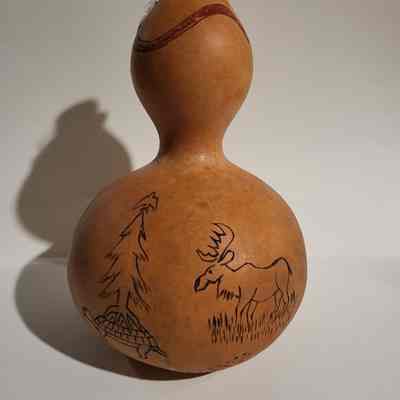
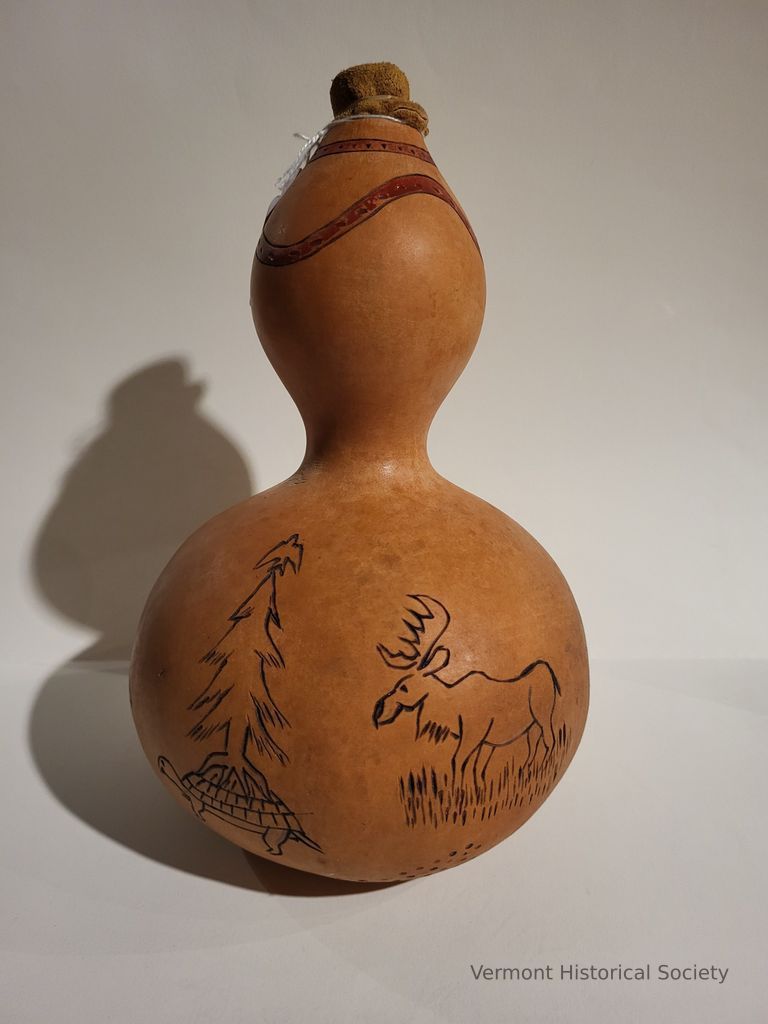
Gourd Rattle
Name/Title
Gourd Rattle
Lexicon
Description
Gourd rattle, marked "Sadoques."
Acquisition
Source (if not Accessioned)
Abenaki Cultural Conservancy
Made/Created
Date made
circa 1995
Entry/Object ID
L2024.3.171
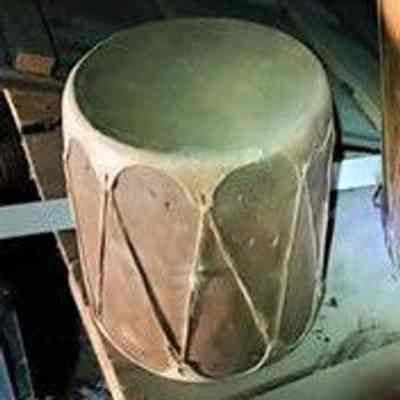
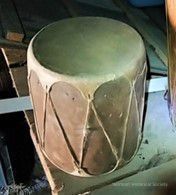
Log Drum
Name/Title
Log Drum
Lexicon
Description
Hollow section of log with skin stretched on each end and secured with cords.
Acquisition
Source (if not Accessioned)
Abenaki Cultural Conservancy
Made/Created
Date made
circa 1900
Materials
Material
Wood, Leather
Entry/Object ID
L2024.3.189
Context
This typical Taos or Hopi log drum was used by a Missisquoi elder and herbalist Bob Wells from the early/mid-20th century into the early 1990’s when it was given to Frederick Wiseman to document Abenaki culture. As shown in tourist postcards of “Indian Shops” in Maine and New Hampshire, these drums were imported in large numbers into the Northeast and sold as souvenirs, and this trade was probably the source of this Mr. Wells’ drum. There are few remaining Wabanaki drums from this period.

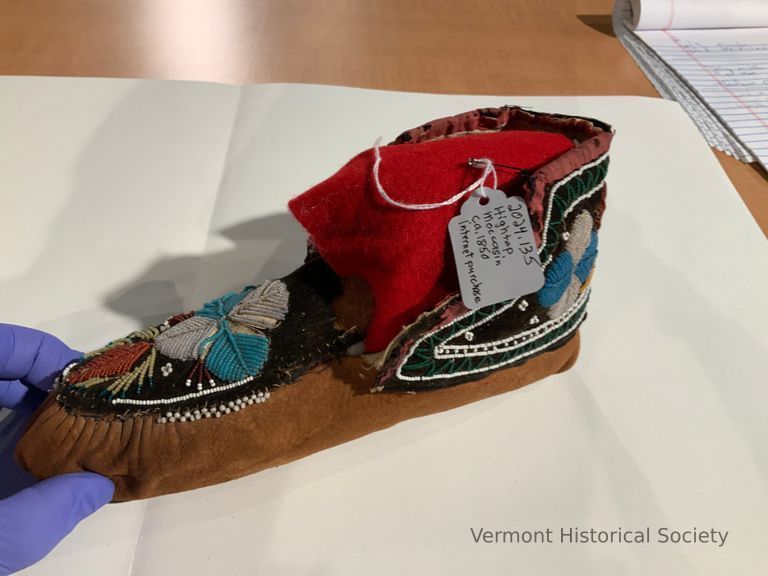
Moccasin
Name/Title
Moccasin
Lexicon
Description
High-top, hide moccasin with blue and white, beaded quatrefoil design. Zig-zag border on heel.
Acquisition
Source (if not Accessioned)
Abenaki Cultural Conservancy
Ethnography
Made/Created
Date made
circa 1850
Entry/Object ID
L2024.3.135
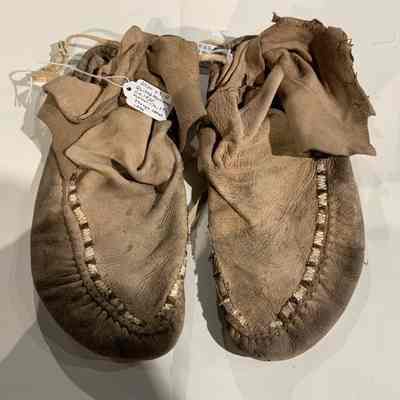
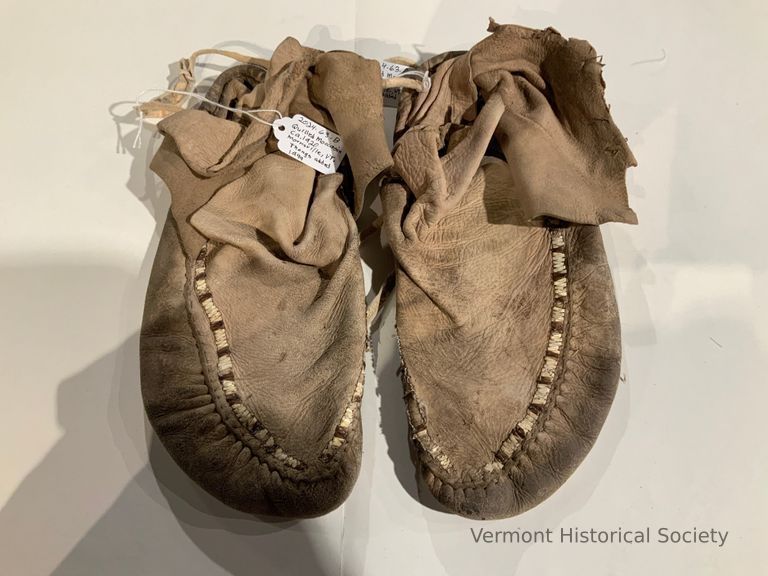
Moccasins
Name/Title
Moccasins
Lexicon
Clothing/Dress/Costume Details
Article of Clothing/Dress/Costume
Moccasins
Description
Quilled leather moccasins. Thongs added in 1999.
Acquisition
Source (if not Accessioned)
Abenaki Cultural Conservancy
Made/Created
Date made
circa 1920
Entry/Object ID
L2024.3.63a-b
Context
These are strange pieces, they are of modern style commercial tanned leather, and the porcupine quilling is excellent but does not use dyed quills. The pair is probably a revival piece of some kind, but I am unsure of the prototype.
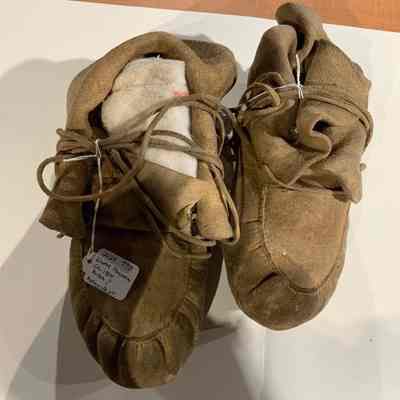
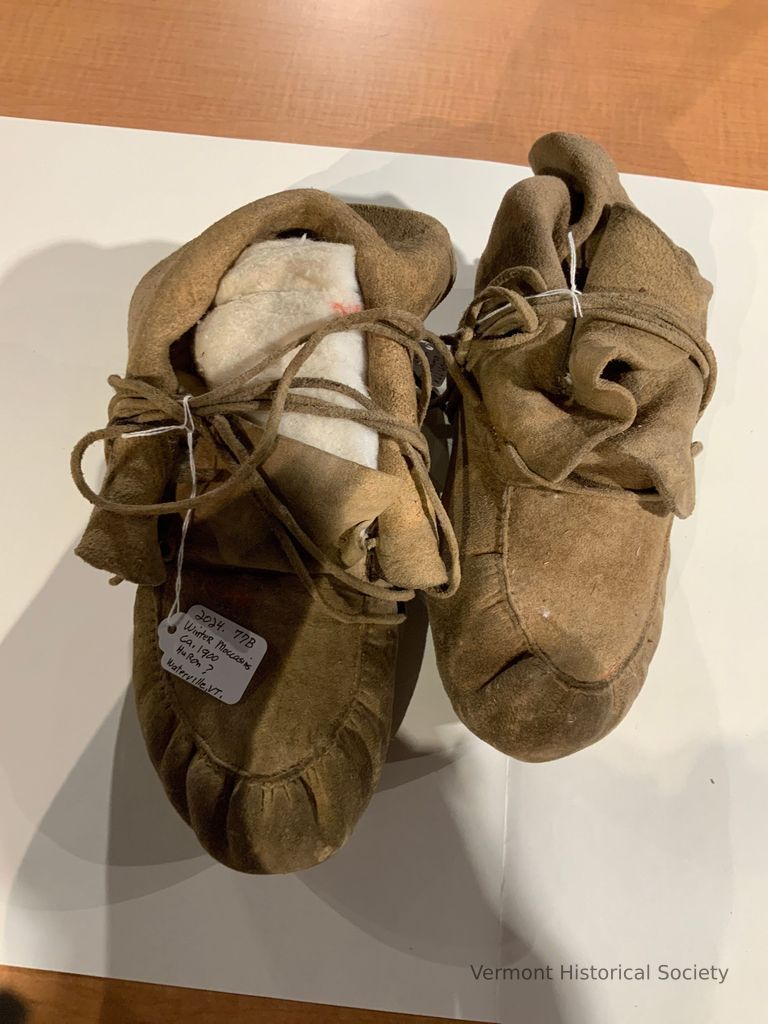
Moccasins
Name/Title
Moccasins
Lexicon
Clothing/Dress/Costume Details
Article of Clothing/Dress/Costume
Moccasins
Textile Details
Leather
Material
Description
Winter Moccasins of possibly Huron manufacture
Acquisition
Source (if not Accessioned)
Abenaki Cultural Conservancy
Made/Created
Date made
circa 1900
Entry/Object ID
L2024.3.77a-b
Context
Traded or sold to Abenaki family
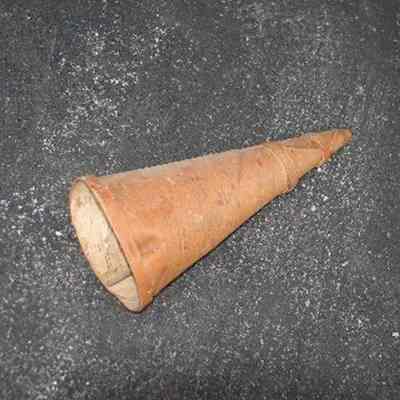
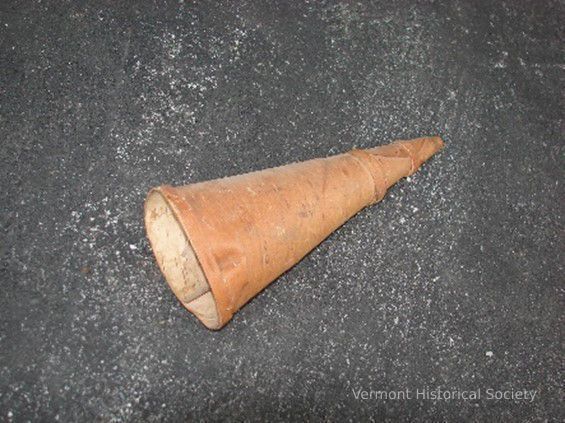
Moose Call
Name/Title
Moose Call
Lexicon
Description
Birchbark cone with three bark bands
Use
Moose calling
Acquisition
Source (if not Accessioned)
Abenaki Cultural Conservancy
Ethnography
Made/Created
Date made
circa 1900
Materials
Material
Birch
Entry/Object ID
L2024.3.107
Context
Native made moose calls are very common in Maine but are relatively rare in Vermont and New Hampshire and only come from scattered woods and lake camps in the Northeast Kingdom in Vermont to Western Maine. This one was made to use, not a tourist souvenir.
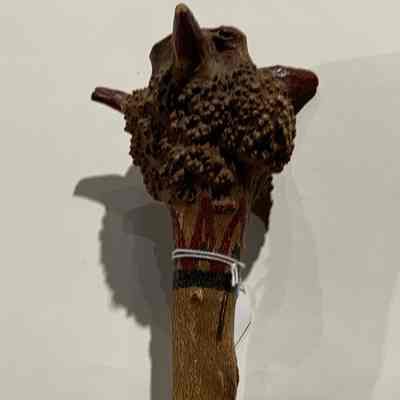
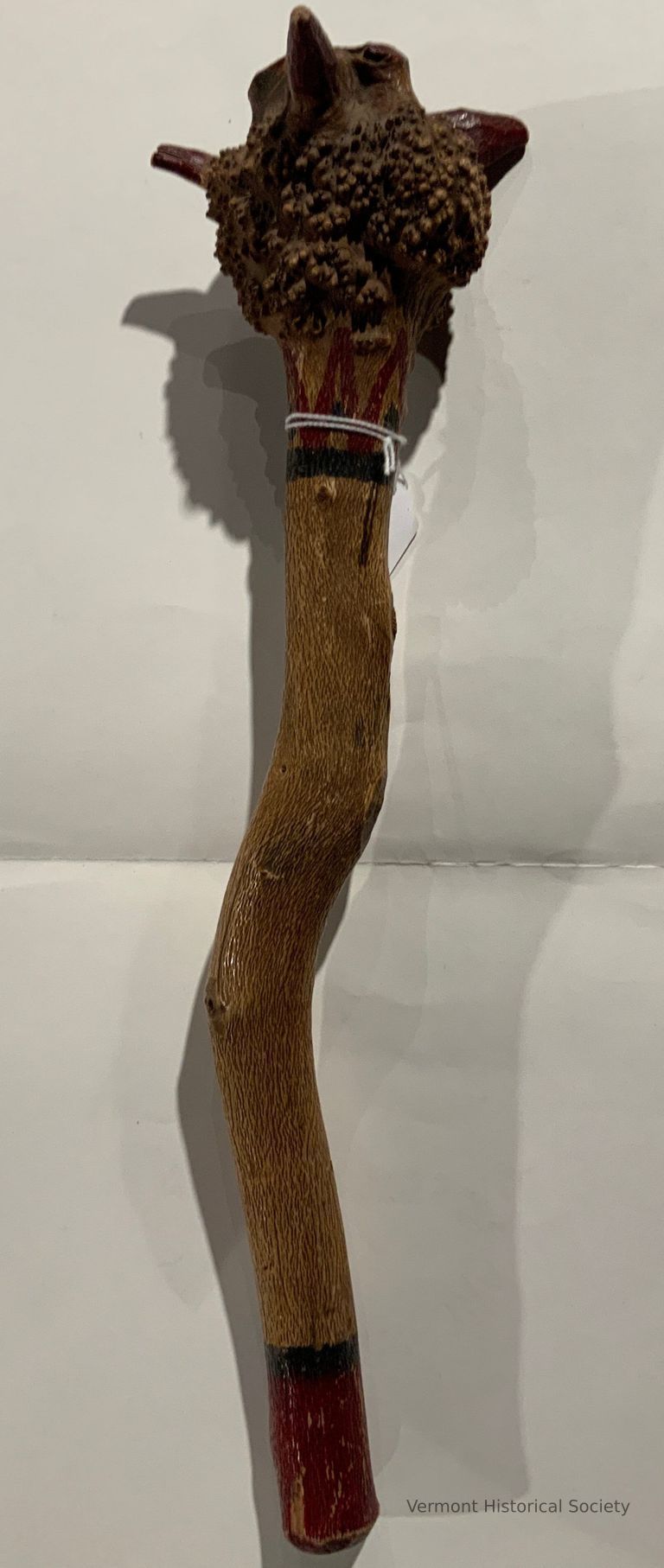
Root Club
Name/Title
Root Club
Lexicon
Description
Club crafted from natural root ball
Acquisition
Source (if not Accessioned)
Abenaki Cultural Conservancy
Made/Created
Date made
circa 1870
Materials
Material
Wood
Entry/Object ID
L2024.3.49
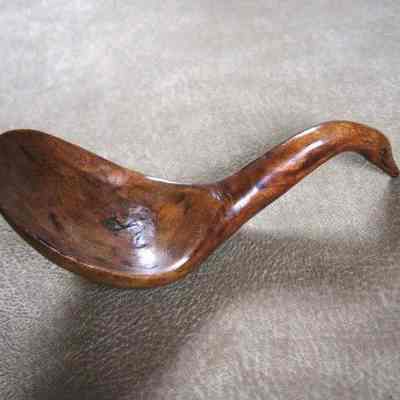
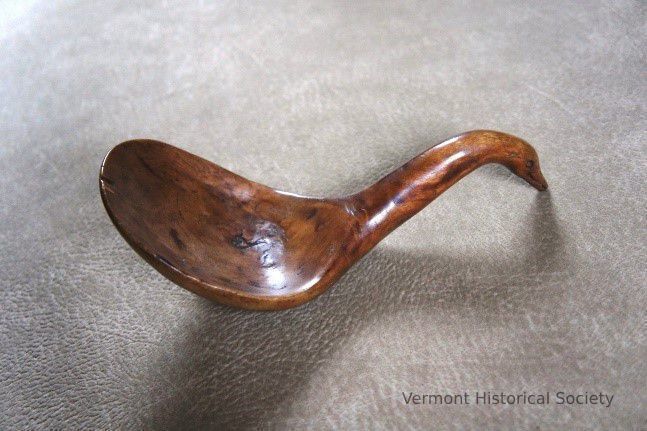
Spoon
Name/Title
Spoon
Lexicon
Description
Maple burl spoon with curving handle carved in the form of a bird's head
Acquisition
Source (if not Accessioned)
Abenaki Cultural Conservancy
Ethnography
Made/Created
Date made
circa 1750
Materials
Material Notes
Burl
Material
Maple
Entry/Object ID
L2024.3.26
Context
The maple burl spoon has an effigy of a waterbird on the handle and is a wonderful example of the ceremonial spoon of the mid-18th century that continued to be used in the end of the century.
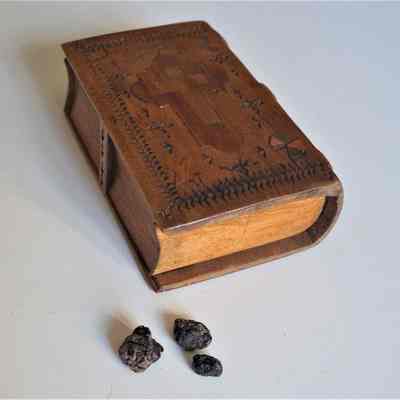

Spruce Gum Box
Name/Title
Spruce Gum Box
Lexicon
Description
Wooden box carved in the form of a book. Inlay cross, stars, and pinwheels on the cover with chip-carved decoration surrounding. Three pieces of spruce gum [resin] contained in the box.
Acquisition
Source (if not Accessioned)
Abenaki Cultural Conservancy
Made/Created
Date made
circa 1900
Materials
Material
Wood
Entry/Object ID
L2024.3.52
Context
This box, although typical of French culture, has typical Northeastern Native style triangular toothed chip carving. It is carved to look like a small missal or bible with a marquetry cross on one side. There are still oxidized pieces of spruce gum remaining inside.
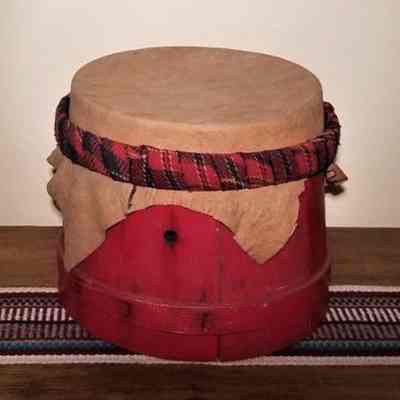
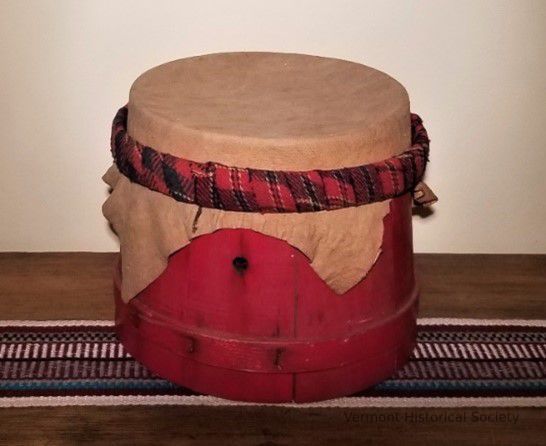
Water Drum
Name/Title
Water Drum
Lexicon
Description
Small drum made from wooden staves and banded with wooden hoops and metal staples. Probably an adapted firkin. Skin drumhead is stretched over the top. Red and black flannel, decorative band (probably added later). Interior of the drum is sealed with asphalt.
Acquisition
Source (if not Accessioned)
Abenaki Cultural Conservancy
Ethnography
Made/Created
Date made
circa 1900
Materials
Material
Wood, Leather
Entry/Object ID
L2024.3.84
Context
This typical Northeastern Water Drum was made from a mid/late 19th century firkin with stapled hoops. It was modified by thinning the lip of the firkin and sealing the inside with asphalt. Although this came from southern New Hampshire, there is no historical references for water drums being historically used in that area.